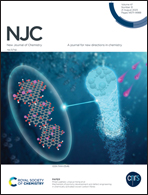NH2-MIL-125/g-C3N4/Bi2O3/Ti photoanode for visible light responsive photocatalytic fuel cell degradation of rhodamine B and electricity generation
Abstract
The low electron–hole separation in the photoanode generally restricts the visible light response of photocatalytic fuel cell (PFCs). In this study, 5% NH2-MIL-125/g-C3N4/Bi2O3/Ti photoanode was synthesized and assembled with a PFC with Cu cathode to degrade rhodamine B and generate electricity. With visible light irritation, the maximum photocurrent density, maximum power density, and degradation rate of the PFC were 0.59 mA cm−2, 29.88 μW cm−2, and 97.48% (1 h), respectively. The major active species in the PFC were h+, ˙O2−, and ˙OH. The good performance of the PFC was ascribed to the formation of a double Z-type heterojunction in the 5% NH2-MIL-125/g-C3N4/Bi2O3/Ti photoanode so that the photoelectrons of NH2-MIL-125 and Bi2O3 directly combine with the photoholes of g-C3N4, making the photoholes of NH2-MIL-125 and Bi2O3 and the photoelectrons of g-C3N4 directly or indirectly involved in the RhB degradation process and generating electricity. Thus, the separation rate of the e−–h+ pairs in the photoanode and the capability of the PFC are greatly improved.



 Please wait while we load your content...
Please wait while we load your content...